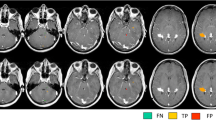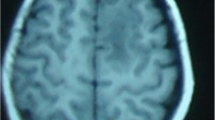Abstract
Purpose
This study was conducted to determine the benefit of magnetic resonance imaging (MRI) at 7 T in detecting structural lesions and previously unidentified abnormalities in patients with tuberous sclerosis complex (TSC).
Methods
Thirteen patients with TSC (8–36 years, seven males) previously diagnosed by 3 T MRI underwent additional imaging at 7 T, which included T1-weighted magnetization-prepared rapid gradient-echo (MPRAGE), T2-weighted turbo spin echo (TSE), SPACE fluid attenuated inversion recovery (FLAIR), susceptibility weighted imaging (SWI), white matter suppressed (WM-suppressed), and gray-white matter tissue border enhancement (GW-TBE) MPRAGE sequences. Subtle lesions, tuberal morphology, and perituberal cortex abnormalities were examined and compared to those observed at 3 T MRI using standard sequences.
Results
Improved visualization of TSC lesions was achieved in all subjects at 7 T compared to 3 T imaging, and three subjects received resective surgery. The 7 T T1- and T2-weighted images had high spatial resolution and provided a clear delineation of the perituberal cortex. SWI revealed abnormal blood vessel morphology. WM-suppressed and GW-TBE protocols, adjusted specifically for TSC imaging, aided in visualizing lesions and uncovered more extensive subtle lesions and abnormalities beyond the conventionally detected tubers.
Conclusions
Due to its high spatial resolution and powerful new imaging protocols, 7 T MRI provided a better evaluation of subtle lesions and perituberal details compared with conventional MRI at 3 T, with potential implications for diagnosis and operative treatment of TSC and its related epilepsy.






Similar content being viewed by others
Abbreviations
- TSC:
-
Tuberous sclerosis complex
- MPRAGE:
-
Magnetization-prepared rapid gradient-echo
- FLAIR:
-
Fluid attenuated inversion recovery
- SWI:
-
Susceptibility weighted imaging
- WM-suppressed:
-
White matter suppressed
- GW-TBE:
-
Gray-white matter tissue border enhancement
- TSE:
-
Turbo spin echo
- SNR:
-
Signal-to-noise ratio
- EEG:
-
Electroencephalography
- PET:
-
Positron emission computed tomography
- SEEG:
-
Stereotactic intracranial EEG
References
Crino PB, Nathanson KL, Henske EP (2006) The tuberous sclerosis complex. N Engl J Med 355:1345–1356. https://doi.org/10.1056/NEJMra055323
Major P, Rakowski S, Simon MV, Cheng ML, Eskandar E, Baron J, Leeman BA, Frosch MP, Thiele EA (2009) Are cortical tubers epileptogenic? Evidence from electrocorticography. Epilepsia 50:147–154. https://doi.org/10.1111/j.1528-1167.2008.01814.x
Smalley SL (1998) Autism and tuberous sclerosis. J Autism Dev Disord 28:407–414. https://doi.org/10.1023/A:1026052421693
Thiele EA (2004) Managing epilepsy in tuberous sclerosis complex. J Child Neurol 19:680–686. https://doi.org/10.1177/08830738040190090801
Prather P, de Vries PJ (2004) Behavioral and cognitive aspects of tuberous sclerosis complex. J Child Neurol 19:666–674. https://doi.org/10.1177/08830738040190090601
Jozwiak S, Goodman M, Lamm SH (1998) Poor mental development in patients with tuberous sclerosis complex: clinical risk factors. Arch Neurol 55:379–384. https://doi.org/10.1001/archneur.55.3.379
Ohtsuka Y, Ohmori I, Oka E (1998) Long-term follow-up of childhood epilepsy associated with tuberous sclerosis. Epilepsia 39:1158–1163. https://doi.org/10.1200/JCO.2010.28.4786
Zaroff CM, Devinsky O, Miles D, Barr WB (2004) Cognitive and behavioral correlates of tuberous sclerosis complex. J Child Neurol 19:847–852
Curatolo P, Bombardieri R, Verdecchia M, Seri S (2005) Intractable seizures in tuberous sclerosis complex: from molecular pathogenesis to the rationale for treatment. J Child Neurol 20:318–325. https://doi.org/10.1177/08830738050200040901
Nixon JR, Miller GM, Okazaki H, Gomez MR (1989) Cerebral tuberous sclerosis: postmortem magnetic resonance imaging and pathologic anatomy. Mayo Clin Proc 64:305–311. https://doi.org/10.1016/S0025-6196(12)65250-1
Moore KR, Funke ME, Constantino T, Katzman GL, Lewine JD (2002) Magnetoencephalographically directed review of high-spatial-resolution surface-coil MR images improves lesion detection in patients with extratemporal epilepsy. Radiology 225:880–887. https://doi.org/10.1148/radiol.2253011597
Chalifoux JR, Perry N, Katz JS, Wiggins GC, Roth J, Miles D, Devinsky O, Weiner HL, Milla SS (2013) The ability of high field strength 7-T magnetic resonance imaging to reveal previously uncharacterized brain lesions in patients with tuberous sclerosis complex. J Neurosurg Pediatr 11:268–273. https://doi.org/10.3171/2012.12.PEDS12338
Carlson C, Teutonico F, Elliott RE, Moshel YA, LaJoie J, Miles D, Devinsky O, Weiner HL (2011) Bilateral invasive electroencephalography in patients with tuberous sclerosis complex: a path to surgery? J Neurosurg Pediatr 7:421–430. https://doi.org/10.3171/2011.1.PEDS10348
Gallagher A, Chu-Shore CJ, Montenegro MA, Major P, Costello DJ, Lyczkowski DA, Muzykewicz D, Doherty C, Thiele EA (2009) Associations between electroencephalographic and magnetic resonance imaging findings in tuberous sclerosis complex. Epilepsy Res 87:197–202. https://doi.org/10.1016/j.eplepsyres.2009.09.001
Jacobs J, Rohr A, Moeller F, Boor R, Kobayashi E, LeVan Meng P, Stephani U, Gotman J, Siniatchkin M (2008) Evaluation of epileptogenic networks in children with tuberous sclerosis complex using EEG-fMRI. Epilepsia 49:816–825. https://doi.org/10.1111/j.1528-1167.2007.01486.x
Leal AJR, Dias AI, Vieira JP, Moreira A, Távora L, Calado E (2008) Analysis of the dynamics and origin of epileptic activity in patients with tuberous sclerosis evaluated for surgery of epilepsy. Clin Neurophysiol 119:853–861. https://doi.org/10.1016/j.clinph.2007.11.176
Kamimura T, Tohyama J, Oishi M, Akasaka N, Kanazawa O, Sasagawa M, Kato M, Ohno K, Masuda H, Kameyama S, Uchiyama M (2006) Magnetoencephalography in patients with tuberous sclerosis and localization-related epilepsy. Epilepsia 47:991–997. https://doi.org/10.1111/j.1528-1167.2006.00511.x
Moshel YA, Elliott R, Teutonico F, Sellin J, Carlson C, Devinsky O, Weiner HL (2010) Do tubers contain function? Resection of epileptogenic foci in perirolandic cortex in children with tuberous sclerosis complex. Epilepsia 51:1242–1251. https://doi.org/10.1111/j.1528-1167.2009.02493.x
Henry TR, Chupin M, Lehéricy S et al (2011) Hippocampal sclerosis in temporal lobe epilepsy: findings at 7 T. Radiology 261:199–209. https://doi.org/10.1148/radiol.11101651
De Ciantis A, Barkovich AJ, Cosottini M et al (2015) Ultra-high-field MR imaging in polymicrogyria and epilepsy. Am J Neuroradiol 36:309–316. https://doi.org/10.3174/ajnr.A4116
De Ciantis A, Barba C, Tassi L et al (2016) 7T MRI in focal epilepsy with unrevealing conventional field strength imaging. Epilepsia 57:445–454. https://doi.org/10.1111/epi.13313
Roach ES, Sparagana SP (2004) Diagnosis of tuberous sclerosis complex. J Child Neurol 19:643–649. https://doi.org/10.1177/08830738040190090301
Saranathan M, Tourdias T, Bayram E, Ghanouni P, Rutt BK (2015) Optimization of white-matter-nulled magnetization prepared rapid gradient echo (MP-RAGE) imaging. Magn Reson Med 73:1786–1794. https://doi.org/10.1002/mrm.25298
Costagli M, Kelley DAC, Symms MR, Biagi L, Stara R, Maggioni E, Tiberi G, Barba C, Guerrini R, Cosottini M, Tosetti M (2014) Tissue border enhancement by inversion recovery MRI at 7.0 tesla. Neuroradiology 56:517–523. https://doi.org/10.1007/s00234-014-1365-8
Brown M, Semelka R, Nishino TK (2004) MRI: basic principles and applications, 3rd edition. Med Phys. https://doi.org/10.1118/1.1636163
Sinclair D (2004) MRI principles. Radiography 10:241. https://doi.org/10.1016/j.radi.2004.04.001
Ridler K, Bullmore ET, De Vries PJ et al (2001) Widespread anatomical abnormalities of grey and white matter structure in tuberous sclerosis. Psychol Med 31:1437–1446. https://doi.org/10.1017/S0033291701004561
Xiao Z, Xiang J, Holowka S, Hunjan A, Sharma R, Otsubo H, Chuang S (2006) Volumetric localization of epileptic activities in tuberous sclerosis using synthetic aperture magnetometry. Pediatr Radiol 36:16–21. https://doi.org/10.1007/s00247-005-0013-1
Ruppe V, Dilsiz P, Reiss CS, Carlson C, Devinsky O, Zagzag D, Weiner HL, Talos DM (2014) Developmental brain abnormalities in tuberous sclerosis complex: a comparative tissue analysis of cortical tubers and perituberal cortex. Epilepsia 55:539–550. https://doi.org/10.1111/epi.12545
Kannan L, Vogrin S, Bailey C, Maixner W, Harvey AS (2016) Centre of epileptogenic tubers generate and propagate seizures in tuberous sclerosis. Brain 139:2653–2667. https://doi.org/10.1093/brain/aww192
Tong KA, Ashwal S, Obenaus A, Nickerson JP, Kido D, Haacke EM (2008) Susceptibility-weighted MR imaging: a review of clinical applications in children. AJNR Am J Neuroradiol 29:9–17. https://doi.org/10.3174/ajnr.A0786
Thomas B, Somasundaram S, Thamburaj K, Kesavadas C, Gupta AK, Bodhey NK, Kapilamoorthy TR (2008) Clinical applications of susceptibility weighted MR imaging of the brain—a pictorial review. Neuroradiology 50:105–116. https://doi.org/10.1007/s00234-007-0316-z
Haacke EM, Mittal S, Wu Z, Neelavalli J, Cheng YCN (2009) Susceptibility-weighted imaging: technical aspects and clinical applications, part 1. Am J Neuroradiol 30:19–30. https://doi.org/10.3174/ajnr.A1400
Griffiths PD, Bolton P, Verity C (1998) White matter abnormalities in tuberous sclerosis complex. Acta Radiol 39:482–486
Liang S, Li A, Zhao M, Jiang H, Yu S, Meng X, Sun Y (2010) Epilepsy surgery in tuberous sclerosis complex: emphasis on surgical candidate and neuropsychology. Epilepsia 51:2316–2321. https://doi.org/10.1111/j.1528-1167.2010.02669.x
Wissmeyer M, Altrichter S, Pereira VM, Viallon M, Federspiel A, Seeck M, Schaller K, Lövblad KO (2010) Arterial spin-labeling MRI perfusion in tuberous sclerosis: correlation with PET. J Neuroradiol 37:127–130. https://doi.org/10.1016/j.neurad.2009.05.005
Acknowledgements
We thank the patients and their family members for their cooperation during examination and follow-ups. We would also like to thank Ms. Jing An (Simens Shenzhen MR Ltd.), Ms. Kun Hu and Ms. Ziwei Cheng for their technical assistance in MR experiments and valuable discussions.
Author information
Authors and Affiliations
Corresponding authors
Ethics declarations
Funding
This study was funded in part by the Ministry of Science and Technology of China (MOST) (Grant no. 2015CB351701), the National Nature Science Foundation of China (Grant nos. 31730039 and 81771388) and the Chinese Academy of Sciences Strategic Priority Research Program B (Grant nos. XDB02010001 and XDB02050001).
Conflict of interest
The authors declare that they have no conflict of interest.
Ethical approval
All procedures performed in studies involving human participants were in accordance with the ethical standards of the institutional and/or national research committee and with the 1964 Helsinki declaration and its later amendments or comparable ethical standards.
Informed consent
Informed consent was obtained from all individual participants included in the study.
Additional information
KS and JC are joint first authors and contributed equally to this study.
Rights and permissions
About this article
Cite this article
Sun, K., Cui, J., Wang, B. et al. Magnetic resonance imaging of tuberous sclerosis complex with or without epilepsy at 7 T. Neuroradiology 60, 785–794 (2018). https://doi.org/10.1007/s00234-018-2040-2
Received:
Accepted:
Published:
Issue Date:
DOI: https://doi.org/10.1007/s00234-018-2040-2




